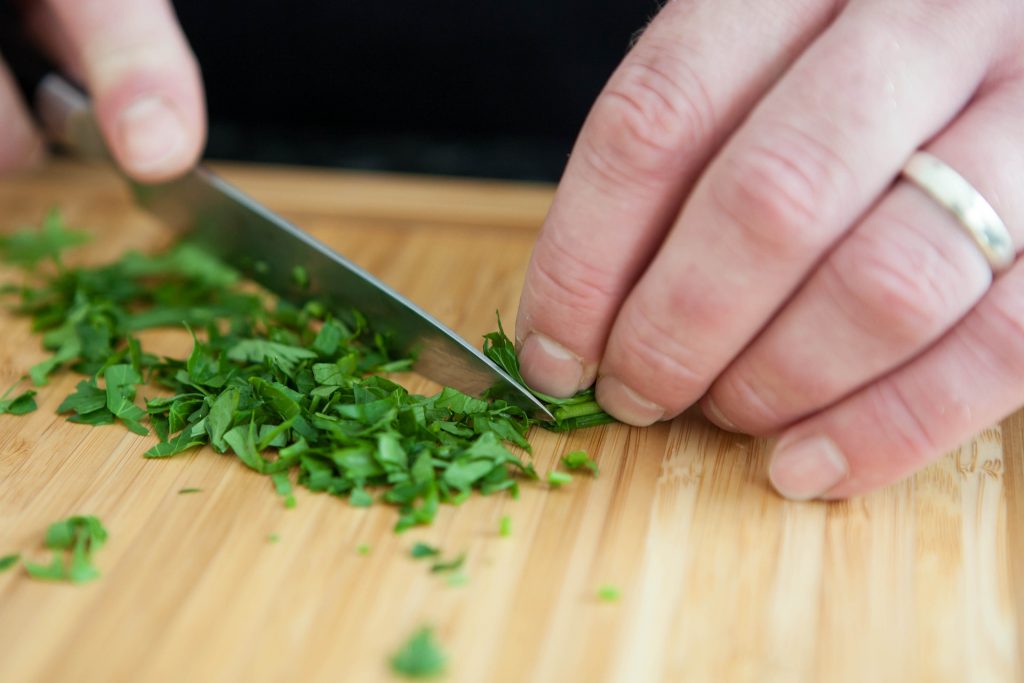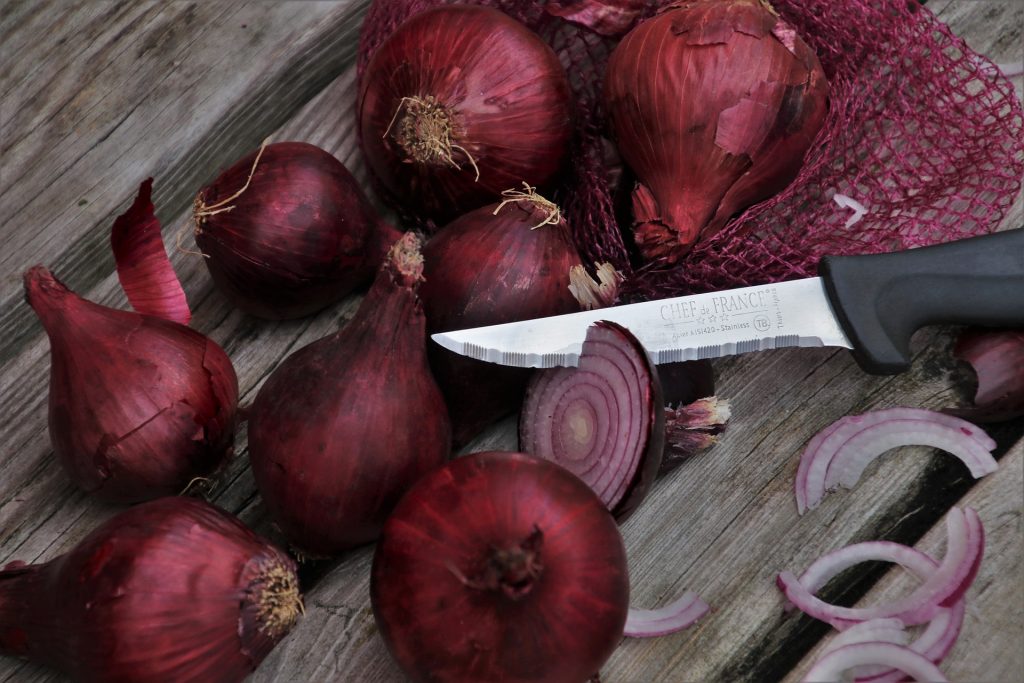
How do you know when you need new knives? We have all experienced that moment when we start to slice a fresh tomato, and it collapses between your fingers and squirts juice over your face. While the tomato looks like roadkill, you look like you’ve had dinner with Hannibal Lector.
Don’t leave your fingers behind when you chop those carrots because the blade doesn’t cut the vegetables and slips across your hand.
Maybe you end up with a flatbread when it comes to cutting a slice of bread because your knife won’t do as it’s told. Yep, you’ve guessed that you need new knives.
Need New Knives
There is only one thing more dangerous than a sharp knife, and that’s a blunt knife. A dull knife means you may need to use more force when preparing food, and consequently, you have less control over the blade. Before you know it, you’re picking up your fingers off the floor. If you can’t cut something as soft as a tomato without making it look like a homicide, then you need new knives.
How to know when to replace your knives
Soft fruit and vegetables look like roadkill, and you feel like you’ve done an arm day at the gym after slicing your carrots.
Good quality, sharp kitchen knives should cut and slice through food without effort. When you prepare food, the knives do the work, not your muscles, and if you break out in a sweat when dicing your beef, then it’s time to examine your equipment!
The Paper trick
It’s a simple enough question. How to know when to replace your knives? A quick trick with a sheet of paper may help you determine the state of your blade and, at the same time, save you a finger.
Hold a sheet of A4 paper lengthways before you. Take your knife and try to slice it down through the paper. If the knife cuts through the paper, then it’s sharp, but if it fails to make the cut, it’s time to invest in a set of sparkly new knives.
Which Knives Do Most Home Cooks Really Need?
A craftsman is only as good as their tools, so the saying goes. The same applies in the kitchen. When we set about creating our culinary masterpieces, having the right equipment makes our lives easier, and in the case of sharp knives, safer.
However, if you need new knives, what do you buy? The answer may not prove easy to answer because it depends on your skill level and what you intend to do in the kitchen.
Understanding your knives and the functions they perform gives you the necessary knowledge to buy the right tool.
For example, you wouldn’t try to slice a tomato with a carving knife, or your kitchen may look like a scene from Alien. However, if you use a paring knife, you end up with elegant tomato slices for your sandwich.
A knife’s purpose in life
As with any task, you must use the right knife for the job. A carving knife won’t cleave through meat, and if it does, then you’re using too much force and may blunt the blade.
Recommended Read: The Many Types of Kitchen Knives: Which Are Right for You?
While a chef’s knife makes a great all-around multi-tasking blade, you may find it difficult to perform delicate tasks such as de-seeding peppers and coring vegetables. However, a neat paring knife may make short work of the task.

A chef’s knife
A chef’s knife forms an excellent multi-tasker for chopping, slicing, and dicing. However, it may prove unwieldy for delicate jobs.
Paring knife
A paring knife forms an essential part of a home cook’s repertoire and performs those delicate, fiddly jobs such as peeling and de-seeding.
Utility knife
A utility knife proves another essential to add to your collection. It fits somewhere between a chef’s knife and a paring knife and tackles those jobs too big for a paring knife or too small for a chef’s knife.
Bread knife
Every household needs a bread knife. How else do you slice open a bagel or cut a bun open for a juicy burger?
Steak knife
A steak knife does what it says on the tin. It’s for cutting into your big juicy steak or any other cooked meat. Don’t use a steak knife for preparing food as that’s not its intention, or you may cut off more than you bargained for.
Fillet knife
A fillet knife makes short work of filleting meat and fish. However, you may use a chef’s knife for the same task with a bit of practice.
Carving knife
A carving knife easily cuts through your cooked meat to form neat slices. However, I have used a chef’s knife for the purpose with excellent results.
Boning knife and cleaver
If you like to butcher meat yourself, then these two knives form an essential part of your knife rack. A cleaver effortlessly cuts through large joints of meat and bone, while the boning knife efficiently helps you remove bones from your joint.
Santoku knife
A Santoku knife effortlessly chops and slices and makes short work of onions and carrots! However, if you have a tight budget, then a chef’s knife may achieve the same goal and save you some money at the same time.
How Much Does a Good Set of Knives Cost?

The best type of knives uses forged handles, which means that the blade and the handle come forged from one metal piece. Consequently, these knives prove durable and robust to provide many years of kitchen service.
A good-quality set of 15 forged kitchen knives starts at around 100 dollars. When you consider that a set of 8 steak knives may cost approximately 33 dollars, the set represents good value for money.
However, prices depend on the brand and quality of the knife set, and you may find alternatives reaching as much as 300 dollars.
Back to basics
As a keen home cook, I use a chef’s multi-tasking knife, a paring knife, a bread knife, and a utility knife. You may expect to pay anything from around 60 dollars for a good quality, forged chef’s knife.
A forged paring knife may put you back around 35 dollars for a 4-inch blade, while a 6-inch utility knife may come in at around 30 dollars. Furthermore, a good-quality forged bread knife may cost approximately 13 dollars.
Budget busting
As with any piece of equipment, the prices vary wildly. Try to invest in the best quality knife you can afford because it lasts longer and performs the task properly. Think about the jobs you perform the most when cooking to understand what type of knife you need and buy the appropriate tool.
However, avoid overly cheap knives. They tend to come with handles riveted onto the blade, which causes an inherent weakness. Consequently, the knife won’t last long, and the blade may start to wobble as you use it. Look for forged knives as they give greater control when working and last longer.
What Is a Forged Handle?
Forged knives usually have a full or partial tang which constitutes an extension of the blade that reaches into the handle.
The handle and the blade effectively form one piece, which adds to the knife’s strength and stability. You may find a handle grip bolted to the tang, or the tang itself comes formed as the handle.
Features of a forged knife
A forged knife has a wider lip called a bolster where it meets the handle. The bolster balances the blade and forms a convenient, safe place to grip the knife between thumb and forefinger.
If the knife has rivets or can see the metal along the edge of the handle, you have a good-quality forged knife.
Stamped alternative
A stamped knife constitutes a blade cut or stamped from a single sheet of metal, then honed and heat-treated for durability. Consequently, a stamped knife offers a cheaper alternative to forged knives.
While a stamped knife may not last as long or feel as heavy in your hand as a forged knife, they offer a cheaper alternative if you find yourself working with a tight budget.
Make Them Last
With a little tender loving care, your knives may last for many years. Store knives separately rather than on top of each other in a drawer, and never use knives for opening those cardboard packages!
Hand-wash your knives rather than use the dishwasher, which may corrode the blades and handles, and never leave them soaking in the sink’s bottom. Dry your knives immediately and put them away safely.
Recommended Read: Carbon Steel Knives Maintenance Tips and Hacks
Need New Knives Explored
A set of good-quality kitchen knives form a home cook’s best friend. Rather than turn your preparation into a Freddy Kruger nightmare, sharp knives allow you to effortlessly cut, slice and dice, and keep your fingers.
You may expect to pay anywhere from 100 dollars for a set of forged kitchen knives. Buying individual knives may cost more but gives you control over the type of knives you want to use. Furthermore, by storing and cleaning your knives properly, you may extend their lives and continue to chop for many years to come.
Author bio
